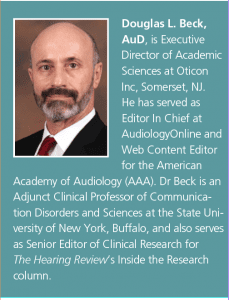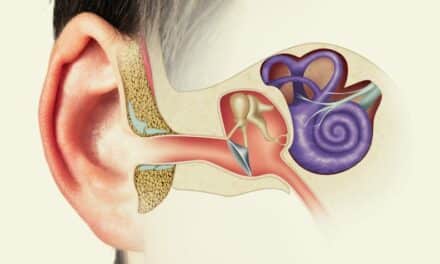Inside the Research | May 2019 Hearing Review
Adam & Jerusha Shulberg are the owners of Cubex Audiology Ltd in London, a private practice that was originally founded by Adam’s father in 1964. Cubex has been at the cutting edge of hearing care for more than half a century. I met the two of them years ago in London. They were both enthusiastic, creative, and passionate about taking care of people. Their approach to hearing healthcare is exciting, and their energy is contagious. Recently, we sat down in the UK and recorded this interview, which is revealing and perhaps instructive, as to how a private practice in the USA might serve the needs of their patients/clients in an increasingly competitive market.
Beck: Hi, Adam and Jerusha! Thanks for meeting with me. As always, it’s a joy to spend time with you two!
Jerusha Shulberg: Thanks Doug. Welcome to London.
Beck: Jumping right in…I’m not sure if my colleagues in the United States know that hearing aids and services are more-or-less free in the UK through the National Health System (NHS). And, of course, “free” is a relative term, meaning the recipients of NHS products and services paid their taxes, which helped support the NHS and more—so I don’t mean to imply that the services and products haven’t been earned; they have been, much like Social Security and Medicare are earned in the US. But, from my perspective, the astonishing thing is that your office has been thriving for more than a half-century, competing with free products. How does that work?
Jerusha S: That’s a great question. As you said, nothing is free. Further, we’re proud of the services and products the NHS provides, as UK citizens really do benefit from NHS provision. Nonetheless, in such a huge system, there are compromises, and although the NHS does a wonderful job, they can’t do everything for everyone, as staffing, costs, and locations all come with restraints. And so, we don’t try to replicate the NHS; we compete successfully because we offer an individualized and highly personal approach to health care.
Beck: And it’s a little unclear to me (in 2019) how NHS provides their care, as the NHS traditionally provided hearing products and services through their own clinics and hospitals, but now they’ve gone to the Any Qualified Provider (AQP) model. Is that right?
Jerusha S: Yes, that’s correct. The NHS had some challenges and they’ve expanded their delivery system to include High Street [mainstreet] retailers and many other AQP outlets, as you’ve indicated. As such, care is provided in multiple situations, and the fitting appointment and counseling can be quite condensed. Further, if the patient is unhappy or needs further care and adjustments, then they might have to go back to their GP to get another referral. So it can be lengthy and frustrating.
As you know, Doug, patients often require a bit more aural rehabilitation, counseling, face-to-face time, and an opportunity to play a role in the optimization of their ability to hear and listen with their technologies, which of course is essential to achieving the best outcome. So our model and goals are different with regard to the management and education of patients and their day-to-day application of protocols. Our goal is to address the needs of each individual patient and their partners with respect to hearing, tinnitus, and balance. We really see our role as a partnership with our patients, providing the tools and skills which ensure they have the very best opportunity to live well.
Beck: So, when a patient arrives at Cubex, what would they experience?
Adam Shulberg: Each patient experience is unique, as we use an individualized approach. When a new patient comes for their initial consultation and discovery session, we schedule a 2-hour slot. Our Customer Services team prepares in advance and has already been in touch with the patient several times before the appointment, ensuring they and the Cubex team have all the information needed to make this a personal, comfortable, and enjoyable experience. Our patients are our guests and are always welcomed and greeted by our team, and made to feel comfortable in our “sitting room” with an herbal tea, infused water, and a variety of coffees. We have soothing sounds throughout the clinic and we’ve used scent management for several years to make this a really pleasant experience that immediately puts people at ease.
The first 45 minutes of their session is spent exploring the reason for their visit—actively listening, understanding, and empathizing. To support this, we would typically use “the Line,” “the Box,” “Goal Sharing for Partners,” and the “Tinnitus Thermometer,” all of which were developed at the Ida Institute (idainstitute.com/tools), to provide us with a good background and knowledge about their situation. We present this as a constructive, positive, and interactive exercise, and consider and discuss their experiences, motivations, expectations, goals, and more. These things are very important to help us learn about their psycho-social-emotional characteristics. Sometimes we need to evaluate their mood and stress levels using the Perceived Stress Scale, and sometimes we might use the Geriatric Depression Scale,1,2 or even cognitive screening tools3 to really understand who we’re working with, and to get a clear picture of the individual and their needs.
After all of that, after we understand and document their psycho-social-emotional characteristics, then we do the audiology testing.
Beck: I suspect you must have psychology support available?
Jerusha S: Yes, we use a multi-disciplinary approach. As such, we do have a consulting psychologist on staff. Other aspects we look at and include are working memory, spatial working memory, executive function, and more, as all of these aspects directly impact their ability to maximally understand speech in noise. If we don’t examine and evaluate these very important areas, then we’re simply guessing, and guessing is not acceptable.
Beck: And I know you’ve also been using the Client Oriented Scale of Improvement (COSI)?4
Adam S: Yes, we’ve been using the COSI for some 25 years and we still find it a very useful tool, although these days we apply it in different ways, flipping it to reflect on what the patient does well. It can also be used to consider partner goals. This is well integrated into our practice to clearly identify daily challenges, expectations, as well as the breakdowns the patient experiences. It also complements the Ida tools that we use and is a great way of verifying the outcome and perceived benefit. Additionally, we use an Active Listening Diary & Cognitive Energy Scale to help us and the patient understand their perceived effort, and later on we might use it for optimizing their technology and evaluating subjective outcomes.
And so, we have an in-depth understanding of the patient before we proceed with audiological tests, recommendations, or treatment—and by understanding this we’re able to focus on problems that brought them in. As you know, many people will present with the same or similar audiogram, yet their needs can be quite unique, and not predictable based solely on an audiogram.
Beck: It seems to me Hearing Care Professionals (HCPs) have, and with good reason, become focused on hearing and hearing loss as an entity. That is, some HCPs may look at hearing loss on an audiogram as the primary problem to be solved. Your approach seems to be more about the whole person and exploring the problems the individual is experiencing, rather than providing amplification to “mirror” the audiogram.
Adam S: That’s fair. I think you’ve stated that, after medical/surgical problems have been ruled out, the audiogram loses its place as the most important issue.5 For most adults, most of the time, the most important issue is their unaided and aided speech-in-noise (SIN) score.6 You’ve also pointed out the pre- and post-fitting SIN score allows the HCP to document the patient’s listening ability in the real world, and to show how much the HCP and his/her amplification protocol has changed the ability of the patient to understand SIN, which is what brings most of them into the office, anyway!
Beck: You’re right, I do say that! But you go further and deeper than the SIN scores, and it appears your solutions are excellent and meaningful—and it takes the clinical practice of audiology and hearing aid dispensing to the next level. And for the USA readers, it seems competing with free is more difficult than competing with OTC, and there are some excellent “takeaway” lessons here, all of which relate to patient-centric service and best practices.
Jerusha S: Yes, our goal is to provide personalized services, as well as the very best technology, counseling, support, realistic expectations, aural rehabilitation, follow-up, and clinical and hearing technology services. We don’t take any shortcuts. We believe each patient deserves our full attention, and we provide that.
Admittedly, it surprises some patients when they realize the depths we go to. But quickly they realize that hearing loss is notjust about their ears, it’s about their work, their social and recreational life, their relationships, their mental health, and more. Of course, sometimes they are expecting a more typical approach and a sales pitch, but they’re almost always delighted to explore the issues in further detail and to realize the benefits they receive because of our in-depth consultation and discovery, as well as the best technology, personally and expertly fitted. We also utilize mindfulness, meditation, lifestyle techniques, cognitive well-being, and other forms of stress relief for our patients and offer coached and supported working memory and mental health-based training.
Beck: Fantastic! And so differentiating yourselves from the traditional approach to hearing aid dispensing appears to not be a problem! It’s refreshing to see Cubex pushing forward the limits and expectations of the HCP to facilitate and provide a better quality of life for the patient.
Adam S: Thanks Doug. We’re looking forward to another 50 years of growth and prosperity and, of course, we’re always looking for ways to improve and expand our clinical offerings.
References
-
Yesavage JA. The use of self-rating depression scales in the elderly. In: Poon LW, Crook T, Davis KL, Eisdorfer C, Gurland BJ, Kaszniak AW, Thompson LW, eds. Handbook for Clinical Memory Assessment of Older Adults. Washington, DC: American Psychological Assn;1986:213-217.
-
Geriatric Depression Scale Short Form (GDS-SF). Psychiatry & Behavioral Health Learning Network. https://www.psychcongress.com/saundras-corner/scales-screeners/depression/geriatric-depression-scale-short-form-gds-sf.
-
Beck DL, Weinstein BE, Harvey M. Issues in cognitive screenings by audiologists. Hearing Review. 2016;23(2):36.
-
Dillon H, James A, Ginis J. Client Oriented Scale of Improvement (COSI) and its relationship to several other measures of benefit and satisfaction provided by hearing aids. J Am Acad Audiol. 1997;8(1):27-43.
-
Beck DL, Danhauer JL, Abrams HB, et al. Audiologic considerations for people with normal hearing sensitivity yet hearing difficulty and/or speech-in-noise problems. Hearing Review. 2018;25(10):28-38.
-
Beck DL, Nilsson M. Speech-in-noise testing: A pragmatic addendum to hearing aid fittings. Hearing Review. 2013;20(5):24-26.
Correspondence to Dr Beck at: [email protected]
Original citation for this article: Beck DL. Patient-centered hearing, balance, and tinnitus care: An interview with Adam & Jerusha Shulberg. Hearing Review. 2019;26(5):28-29










